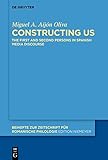Constructing Us : The First and Second Persons in Spanish Media Discourse / Miguel A. Aijón Oliva.
Material type: TextSeries: Beihefte zur Zeitschrift für romanische Philologie ; 435Publisher: Berlin ; Boston : De Gruyter, [2019]Copyright date: ©2019Description: 1 online resource (382 p.)Content type:
TextSeries: Beihefte zur Zeitschrift für romanische Philologie ; 435Publisher: Berlin ; Boston : De Gruyter, [2019]Copyright date: ©2019Description: 1 online resource (382 p.)Content type: - 9783110635645
- 9783110640779
- 9783110643442
- 468 23/eng/20230216
- online - DeGruyter
- Issued also in print.
| Item type | Current library | Call number | URL | Status | Notes | Barcode | |
|---|---|---|---|---|---|---|---|
 eBook
eBook
|
Biblioteca "Angelicum" Pont. Univ. S.Tommaso d'Aquino Nuvola online | online - DeGruyter (Browse shelf(Opens below)) | Online access | Not for loan (Accesso limitato) | Accesso per gli utenti autorizzati / Access for authorized users | (dgr)9783110643442 |
Frontmatter -- Acknowledgments -- Contents -- Outline of this book -- 1. Linguistic choice and the construction of meaning -- 2. Variable grammar: the continuum of syntactic functions -- 3. The first and second persons: discourse in grammar -- 4. The singular first person: the speaker -- 5. The plural first person: more than the speaker -- 6. The singular second person: the addressee -- 7. The plural second person: the audience -- 8. The displaced second persons: addressees and audiences far away -- 9. The construction of style across textual genres -- 10. The construction of style across participant identities -- 11. Conclusions -- 12. References -- Appendices
restricted access online access with authorization star
http://purl.org/coar/access_right/c_16ec
Developments in the analysis of linguistic variation show the need for a theoretical model whereby variants are viewed as cognitively-based communicative choices. In this book, the analysis of the first and second grammatical persons in Spanish media discourse illustrates an approach to linguistic structure and usage as motivated by the need to create meaning at all semiotic levels. Rather than mere sets of deictic forms, persons constitute arrays of functional strategies used by speakers to develop certain representations of themselves and others. The degree of salience attributed to some participant through grammatical configuration – including features like person, way of formulation and syntactic function – strongly conditions the discursive role of that participant, as well as the communicative situation at large. Methodologically, the demonstration conjugates the analysis of quantitative usage patterns with that of specific instances of choice, in order to elucidate the stylistic potential of syntactic forms in media contexts. Understanding variation as the construction of meaning is essential to the scientific advancement of linguistics as an inherently social and cognitive discipline.
Issued also in print.
Mode of access: Internet via World Wide Web.
In English.
Description based on online resource; title from PDF title page (publisher's Web site, viewed 25. Jun 2024)


